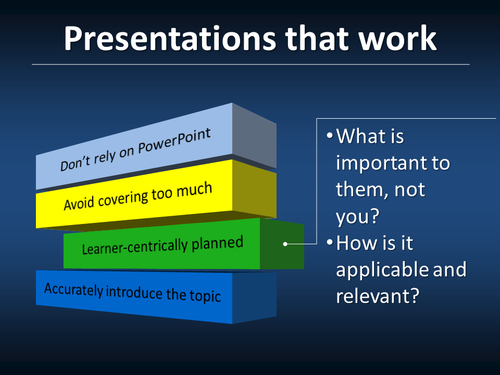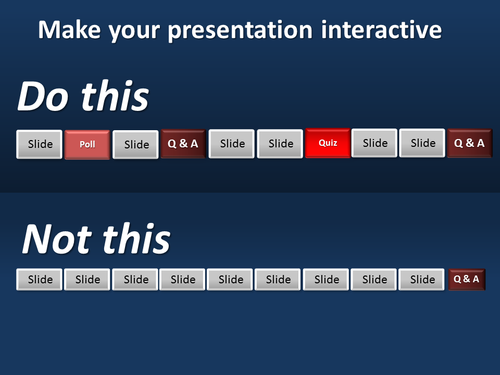What's New in CSIT
Adobe Connect Update
Learn about the new features of Adobe Connect Pro 8 coming March 2011.
Presentation Success: It's all about the learner--not you.
3rd in a 5-part series
"Build it and they will come" does not work in real life. You need a carrot or a stick. Administrators use sticks. We're talking carrots here.
In this post we'll discuss creating your presentation learner-centrically.
Misunderstanding what is important for the audience is a sure way to have your audience not accept the invitation in the first place, or if they do show up, put them to sleep. You need to invest in your own success.
Your first task is to first find out what your audience knows to be relevant and applicable to them. Remember, the audience will always be asking themselves, "What's in it for me?" You need to address that. Tell them how the information you are presenting directly contributes to their job success. You need to do this in the invitation and in the first minute of your presentation. The rest of your presentation should support that fact.
People learn differently and various types of instruction can be effective for each individual. Fifteen years of neuroscience, biology and cognitive psychology research findings on how humans learn offers this powerful and singular conclusion: “It is the one who does the work who does the learning” (Doyle, 2008). Traditionally, the teacher does all the work and the student just sits there expecting it to soak in. At first that may be satisfying but a week later up to 95% of the knowledge transfer has evaporated. Now what?
You can't expect your audience to sit there and absorb your pearls of wisdom and expertise. The learner must be involved in your presentation. Ask them questions. Have them hypothesize.Take polls. Make them calculate. Give them something to do besides sitting there. This is especially important in online or webinar situations. They can be easily distracted by email, their to-do list, etc. Let's face it, they will find any excuse to multi-task if they are not fully engaged in your presentation.
Learner Centric Teaching (LCT) is a major topic is today's field of education. Search for it by name. You'll find plenty of information and ideas on how to engage your audiences regardless of your teaching technology medium.
Up next, how not to bombard your learners.
In this series:
Presentation Success
- How did you screw up your last presentation?
- Accurately introduce the topic
- Plan your presentation learner-centrically (this post)
- Avoid covering too much
- Don't rely on PowerPoint.
This just in! Site Builder 2 administration to be taken offline July 1!
That's right folks!!! The old Site Builder 2.0 allowed us to create sites in ways we hadn’t before, but now, it's time to take it to another level! Site Builder 3.0 adds many new features while simplifying familiar tasks. You can now embed surveys, Datastores, image galleries and content from other ANR systems directly into your sites....

Don't Forget!
Just say no to SEO?
It's been a while since I spent any time thinking about SEO, but a meeting this week about the ANR Catalog, followed by Gerry McGovern's post has me thinking about SEO again. SEO is a valuable tool in helping people find your site, but McGovern warns about the pitfalls of overdoing SEO.
He uses the example of Google. The home page of the Google search engine contains no SEO. He points out that search engines love the Yahoo home page, it contains hundreds of popular words and is strewn with links. Yet Google is tops when it comes to search. Why? Because, according to McGovern, bringing people through your Web site is more important than bringing people to it.
Give the people what they want.
Think about the customer - design your site and your content with the customer, not the search engine crawlers in mind.
Presentation Success: The topic and medium
2nd in a 5-part series
The number one complaint of presentation audiences is the feeling that the presentation wasn't really for them. How can this happen? They invited you, or you invited them. How did that add up to a miss? Let's look at the possibilities.
- You were not fully informed what the audience wanted to learn from you. I was recently invited by a conference committee member to speak on a topic which I diligently prepared for and was psyched-up to deliver. In my opening I asked the audience a few questions and quickly realized they were there to hear something different. I paused and quickly changed my expectations to match theirs. I dumped my PowerPoint and instead had a terrific presentation with a lot of interaction and was free to be more responsive to their questions and could pull up websites that would serve as resources for illustrations and additional information.
- You are putting on a presentation and inviting the wrong audience. This could be a problem if you don't correctly title the event and describe it in your invitation. Be specific in the invitation and make sure your presentation's content matches it. You can exceed the description, but not my very much.
- The medium of communication affects how messages are delivered and perceived.
- Is this live and in-person? Well, at least you can see when your audience squirms, falls asleep, or walks out. In-person, the audience expects a great deal of interaction. Ask them questions, make them calculate, laugh, cheer--something more than just sit there listening. Think of the best presenters you've ever heard, especially great keynote speakers. They keep your attention with great verbal illustrations and get you motivated--all without PowerPoint!
- Is your presentation online in a webinar or pre-recorded? It makes a HUGE difference from in-person events. For one thing, how will you know your audience is still there? That's a clue that your presentation does not meet expectations. You could use the chat or polling features of online delivery programs like Adobe Connect to help you judge how your talk is being received. Are you flexible enough to make adjustments if the feedback during the event is not what you expect? How prepared are you? In many ways, online presentations require a greater investment by you in your own success.
Throughout this post, I've indicated the importance of feedback. Nodding off is a form of feedback. Ask questions when you start, in the middle, and when you're done always provide a feedback mechanism like the ANR Survey Tool for online or pre-recorded presentations. It will give you information you need to find out if you've hit the mark with this audience. You'll use that to make your next presentation even better.
Next, I'll discuss learner motivations.
In this series:
Presentation Success
- How did you screw up your last presentation?
- Accurately introduce the topic (this post)
- Plan your presentation learner-centrically
- Avoid covering too much
- Don't rely on PowerPoint.




